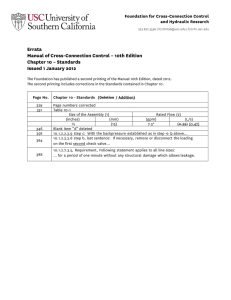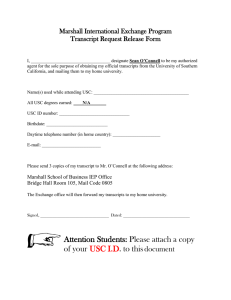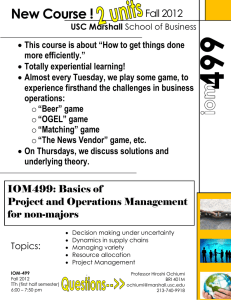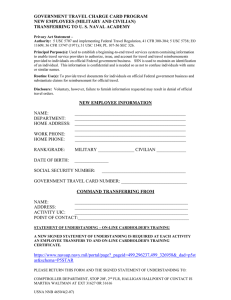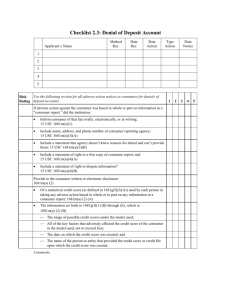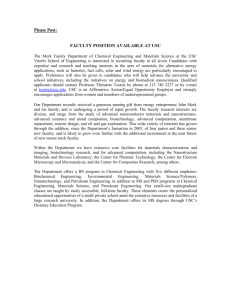Foundation Cross-Connection Control Hydraulic Research
advertisement
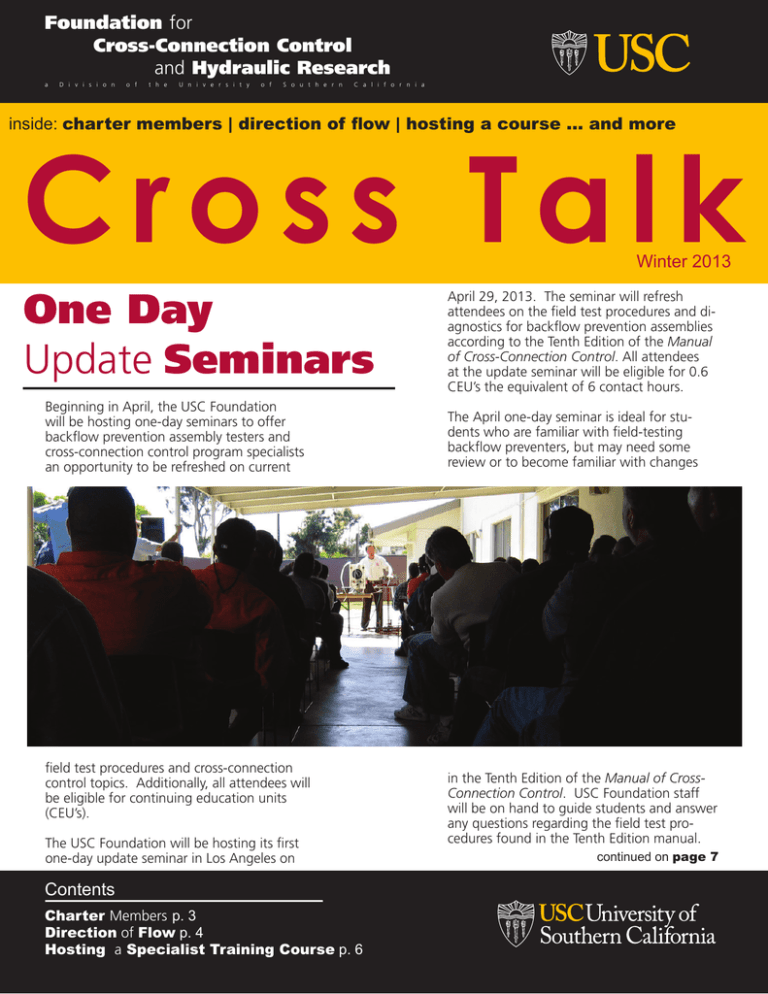
Foundation for Cross-Connection Control and Hydraulic Research a D i v i s i o n o f t h e U n i v e r s i t y o f S o u t h e r n C a l i f o r n i a inside: charter members | direction of flow | hosting a course ... and more Cross Talk Winter 2013 One Day Update Seminars Beginning in April, the USC Foundation will be hosting one-day seminars to offer backflow prevention assembly testers and cross-connection control program specialists an opportunity to be refreshed on current field test procedures and cross-connection control topics. Additionally, all attendees will be eligible for continuing education units (CEU’s). The USC Foundation will be hosting its first one-day update seminar in Los Angeles on Contents Charter Members p. 3 Direction of Flow p. 4 Hosting a Specialist Training Course p. 6 April 29, 2013. The seminar will refresh attendees on the field test procedures and diagnostics for backflow prevention assemblies according to the Tenth Edition of the Manual of Cross-Connection Control. All attendees at the update seminar will be eligible for 0.6 CEU’s the equivalent of 6 contact hours. The April one-day seminar is ideal for students who are familiar with field-testing backflow preventers, but may need some review or to become familiar with changes in the Tenth Edition of the Manual of CrossConnection Control. USC Foundation staff will be on hand to guide students and answer any questions regarding the field test procedures found in the Tenth Edition manual. continued on page 7 Foundation Membership The Foundation’s Membership Program provides many benefits to the Members of the Foundation. These include: a twenty-five percent discount on manuals, twenty percent discount on Foundation Training Courses for any employee of the Member company/organization, the List of Approved Backflow Prevention Assemblies with access to the up-to-the-minute version on the Foundation’s website. Members are encouraged to call the Foundation with technical questions. The Foundation’s Engineering Staff is available to assist Members with the various aspects of field testing backflow preventers, installing backflow preventers and administering their cross-connection control program. Below is a list of those who have become members of the Foundation since the last Cross Talk: Al’s Testing City of Hope B & B Plumbing & Installations Milton Lynn Kurten Cottage Grove, City of New Jersey Alliance of Master Plumbers DS Wagner Construction Pedro Murillo Ramirez First-In Rutland, City of - Water Department General Dynamics Electric Boat The Dalles, City of Green Tech & Health TriMet Transit District GRZ Mechanical, LLC. WSH Company, Inc. Cross Talk is published by the Foundation for Cross-Connection Control and Hydraulic Research, a division of the University of Southern California, for Foundation Members. 2013 © University of Southern California. All rights reserved. Page 2 WINTER 2013 Cross Talk C e l e b r a t i n g 4 5 Ye a r s of the USC Foundation Membership Program Charter Members For over 45 years the USC City of Burbank City of Redlands Foundation membership California Domestic Water Company Rowland Water District program has allowed the USC Foundation to mainCity of El Monte San Bernardino Water Department tain its strong leadership in City of El Segundo City of San Diego backflow prevention and City of Inglewood San Gabriel County Water District cross-connection control. Irvine Ranch Water District San Gabriel Valley Water Company With constant support from its members the USC City of Manhattan Beach City of Signal Hill, Foundation has develCity of Monrovia City of Torrance, oped training courses and Newhall County Water District Vallecitos Water District tools which are valuable City of Oxnard City of Vernon for anyone interested in backflow prevention or Park Water Company & Subsidiaries Walnut Valley Water District cross-connection control. City of Pasadena Yorba Linda Water District And, for that support the USC Foundation would like to acknowledge those water utilities that The SCWUA check helped setup the USC have been there from the start. Foundation membership program. The membership program helps fund the day-today operations of the USC Foundation along with providing for partial funding of research projects that benefit the water distribution industry as a whole. Above is the list of those water utilities, which have supported the USC Foundation from the start and continue to support its membership program. Presentation of the first check by SCWWA On March 1967 the Board of Directors of the Southern California Water Utilities Association (SCWUA), Inc., made up of public and private water utilities, presented USC with a $10,000 check. With this check the SCWUA implemented an agreement with the University for the continuing operation of the USC Foundation. It is important to note that the USC Foundation is a self-funded division of the University of Southern California. The money that is raised through its membership program helps to develop tools like the new Field Testing Backflow Preventers, Instructional Video. Therefore, it is important to the USC Foundation to maintain support for its membership program. With its first set of members, 45 years ago, the USC Foundation has grown to include agencies across the United States. Water and health agencies across the nation have joined the USC Foundation membership program for its exclusive benefits like the List of Approved Backflow Prevention Assemblies and its discounts on training courses and training tools. continued on page 7 Cross Talk WINTER 2013 Page 3 Direction of Flow The direction of flow test on the second check of the reduced pressure principle assembly (RP) has been an area of discussion since the development of the field test procedures found in the Manual of Cross-Connection Control, Ninth Edition. With a direction of flow test, a tester may be able to determine more accurately whether a backflow prevention assembly is operating properly. However, the test is not found in the field test procedures in either the older Ninth Edition or the current Tenth Edition of the manual. However, the direction of flow test is found in the Appendix chapter of each manual. The USC Foundation occasionally receives enquiries regarding the decision not to include the test as part of the field test procedure. The decision whether or not to include the direction of flow test in the field test procedures for the RP was made after much discussion by the Manual Review Committee for the Ninth Edition. The decision to exclude it, from the field test procedure, was made in order to allow each administrative authority to decide independently whether they wanted to make it a requirement in their area of jurisdiction. The direction of flow test provides the backflow prevention assembly tester with more information than the current backpressure test found in the field test procedure for the RP. For example, with the direction of flow test, the tester may be able to determine if the backflow preventer is currently meeting the design criteria, set forth in the Standards found in the Tenth Edition manual, of holding at least 1.0 psid in the direction of flow. The direction of flow test is located in Appendix A of the Tenth Edition Manual (A.2.2). The requirement for this test states, “The static pressure drop across check valve No. 2 shall be at least 1.0 psid. If shutoff valve No. 2 is found to be leaking this test cannot be performed accurately.” Therefore, the direction of flow test provides a higher level of assurance that the assembly is operating the way it was designed to operate. Page 4 WINTER 2013 Cross Talk Also, under certain laboratory conditions, it is possible to create a leak across a check valve such that the check valve will pass the backpressure test and yet fail the direction of flow test. This is done by fouling the check valve just slightly, perhaps by using an object with high degree elasticity like a rubber band. During the direction of flow test the reading may be lower than the 1.0 psid requirement if the loading of the check valve is not high enough to force the check valve to close against the “debris.” With the backpressure test, however, the force exerted on the backside of the check valve may actually force the check valve to seal around the debris or fouling object. It is normally assumed that if the check valve holds in the direction of flow, it would also hold against a backpressure. This is true unless the backpressure is high enough to force a leak through the elastomer disc or actually damage the disc. However, this is highly unlikely because of the USC Foundation laboratory tests performed on the assemblies before they are ever approved or even released to the field evaluation phase of the USC Foundation’s Approval Program. One of the laboratory tests, as noted in the Standards found in the Tenth Edition manual (10.1.2.2.3.1), requires the second check valve to be subjected to a backpressure of twice the maximum working water pressure of the assembly without any damage, permanent deformation or impairment of operation. Any evidence of leakage is cause for rejection. So, aside from certain laboratory conditions, the direction of flow test seems like it should be a part of the field test procedures, but it is not. The field test procedures published in the Tenth Edition manual by the USC Foundation are just that, field test procedures. Therefore, it is important to take into account what is actually occurring in the field as opposed to a laboratory setting. Probably the most common problem, which arises for the field tester, is a leaking shutoff valve. In the field, the tester must be able to perform the test on the backflow preventer realizing that shutoff valves may be leaking. The tester, therefore, either has to repair the leak or compensate for the leak in such a manner that allows for an accurate field test. When testing the RP, the tester may come across a leaking No. 2 shutoff valve. If the leak is slight, the tester may be able to perform the field test by compensating for the leak. However, if the tester is using the direction of flow test for the second check valve, it is necessary to determine if the No. 2 shutoff valve is leaking before performing the test. Otherwise, the test results could be false. Remember, Appendix A.2.2 of the Tenth Edition manual states, “If shutoff valve No. 2 is found to be leaking this test cannot be performed accurately.” Most testers are quite aware of the fact that shutoff valves frequently leak, at least a small amount. It is desirable to obtain an acceptable field test in situations where one or both of the shutoff valves have slight leaks. If it is necessary to repair each shutoff valve before proceeding with the testing of the backflow preventer, many testers would be spending most of their time repairing and replacing shutoff valves instead of testing and repairing backflow preventers. Since the purpose of the shutoff valves is for testing and maintenance, it is acceptable for the shutoff valves to leak slightly as long as the tester can accurately determine the condition of the components preventing backflow. The Manual Review Committee recognized that the direction of flow test for the second check of the RP required a drip tight No. 2 shutoff valve. To possibly fail an RP due to a drip leak in a shutoff valve was not considered appropriate for a field test. None of the field test procedures contained in the Manual require that the shutoff valves hold drip tight to perform an accurate field test. Therefore, the USC Foundation decided not to include the direction of flow test in the field test for the second check of the RP. Making it a requirement would amount to testers spending most of their time verifying and repairing No. 2 shutoff valves to meet the drip tight requirement. Since, it is possible to detect a leaking No. 2 shutoff valve and compensate for the leak allowing an acceptable field test, the backpressure test was included as part of the field test for the reduced pressure principle assembly. But, realizing many administrative authorities will want to use the direction of flow test in order to get as much data as possible in order to ascertain the condition of the assembly; the direction of flow test is included in Appendix A (A.2.2) of the Tenth Edition Manual. g A check valve that is leaking (i.e., 0.0 psid) at a static condition may actually show an acceptable reading of 1.0 psid or greater should there be water flowing through the assembly. Cross Talk WINTER 2013 Page 5 Hosting a Specialist Training Course Education is crucial for anyone interested in becoming involved in backflow prevention or cross-connection control. Therefore, the USC Foundation continues to make available training courses in administering a cross-connec- tion control program. Many of these courses are made available throughout the year in the Los Angeles area. However, the USC Foundation understands that some students may not be able to travel to the Los Angeles area and in those instances the USC Foundation encourages members to think about hosting a USC Foundation training course. Hosting a course provides an opportunity for those involved with cross-connection control and backflow prevention in various parts of the country to be trained by the USC Foundation Staff as cross-connection control specialists. The USC Foundation staff has offered training courses in Texas, Hawaii, South Carolina, Indiana, Nevada, Louisiana and other areas. There is no cost for the hosting agency to host a USC Foundation training course. And, the hosting organization will receive complimentary registration for two attendees. The following are the main items to consider in the decision to host a USC Foundation Specialist training course: The Specialist Course The USC Foundation’s Course for the Training of Cross-Connection Control Program Specialists is designed to train the attendees in the various aspects involved in administering a Page 6 WINTER 2013 cross-connection control program. Main topics discussed are: Rules & Regulations, Policies & Procedures, Record Keeping, Plan Checks, Public Relations and Site Surveys. Much of the course is dedicated to the site survey to help the attendee assess the degree of hazard at any water using facility. The course includes a short survey of a facility as part of the examination. Meeting Place: The meeting place should be a room large enough to accommodate approximately 30 course participants. The room should have a whiteboard with pens, along with being suitable for multimedia presentations. Course Materials: The USC Foundation will provide, for each student, a binder containing a syllabus, a time schedule for the week and several reference materials. Also provided, for each student, will be a current copy of the Manual of CrossConnection Control. In addition, the contact for the hosting agency should provide the USC Foundation office with local and state regulations so that the instructors can adjust the course to the legal requirements of the region. The USC Foundation will provide a ‘‘certificate of completion’’ for each student of the class who successfully completes the course. Also, continuing education units (CEU’s) are given to students who attend every day of the course. Specialist course students receive 3.7 CEU’s the equivalent of 37 contact hours. Field Survey: The hosting organization needs to locate facilities, which will be suitable for field surveys on Tuesday afternoon and Thursday morning of the class. The facilities should be located nearby the classroom and should have several water uses. There should be at least three separate and diverse water uses located at the facility. Before the site is finalized and the proper permission is sought for the surveys, the host- Cross Talk ing organization contact should call the USC Foundation office and discuss the facility with one of the course instructors. In many cases a course instructor will preview the proposed survey locations in advance of the class to verify their suitability for this portion of the class. On Thursday morning of the class, the students will then be required to survey the locations to determine the uses of water, whether there are any actual or potential cross-connections and ultimately determine the degree of hazard and appropriate backflow protection. A separate location is necessary for an instructor led presurvey, on Tuesday afternoon. Hosting a USC Foundation Specialist course is surprisingly easy and can be beneficial for any USC Foundation member. Hosting a course gives any member the opportunity to have employees involved with cross-connection control and backflow prevention informed about the latest developments in the field. Registration will be handled directly by the USC Foundation office. Prior to the announcement of the course, the hosting agency may be asked to recommend local accommodations for those not in the immediate area. Course attendees must submit a registration application with payment. The USC Foundation will then mail a confirmation letter to all course participants. The USC Foundation office is currently in the process of scheduling courses for 2014. If any USC Foundation member is interested in hosting one of the Specialist training courses, please visit the USC Foundation’s website or contact the office to obtain a detailed hosting outline or discuss the possibility with one of the USC Foundation’s instructors. g charter members: continued continued from page 3 In addition to its members nationally, the USC Foundation also includes international members from countries around the world seeking to receive the latest information regarding backflow prevention and cross-connection control. With the continued support of the members the USC Foundation will continue to develop new training courses and training tools for the considerable future. g seminars: continued continued from page 1 Discussions will include the differences between the Ninth and Tenth Edition field test procedures and diagnostic scenarios that may be causing a backflow preventer to fail during the field test procedure. The one-day seminar is not meant to be a replacement for the USC Foundation week long tester training courses. For those students new to testing backflow preventers, the USC Foundation continues to recommend the week long tester training course. In the future the USC Foundation’s one-day seminars will cover topics such as establishing a cross-connection control program, site surveys, hydraulics and rules/regulations to name a few. Attending the one-day seminar may also help fulfill a student’s requirements for CEU’s. Many students who attend a USC Foundation training course follow it up by taking a certification exam from a local health/water department or from a national organization. Many of these certification organizations require that the student complete a number of contact hours to maintain their certification year after year. As mentioned above, students at the one-day seminar will be eligible for 0.6 CEU’s, the equivalent of 6 contact hours. Registration for the one-day seminar may be found on the USC Foundation’s website or students may contact the USC Foundation office for more information. g Cross Talk WINTER 2013 Page 7 Training Courses Tester Course Los Angeles, CA 22-26 April 2013 Los Angeles, CA 15-19 July 2013 Upcoming Events Nebraska ABPA Region 12 Conference Kearney, NE 6 March 2013 Specialist Course CA/NV AWWA Spring Conference Las Vegas, NV 25-28 March 2013 Los Angeles, CA 29 July - 2 August 2013 CEHA 62nd Annual Educational Symposium Los Angeles, CA 1-4 April 2013 Los Angeles, CA 18-22 March 2013 One-Day Update Seminar Los Angeles, CA 29 April 2013 Social Media follow us at twitter.com/uscfccchr become a fan by clicking ‘Like’ on our facebook page facebook.com/uscfccchr Foundation for Cross-Connection Control and Hydraulic Research University of Southern California Kaprielian Hall 200 3620 South Vermont Avenue Los Angeles, California 90089-2531 Contact Information Phone: 866-545-6340 Fax: 213-740-8399 E-mail: fccchr@usc.edu Website: fccchr.usc.edu First Class US Postage PAID University of Southern California
